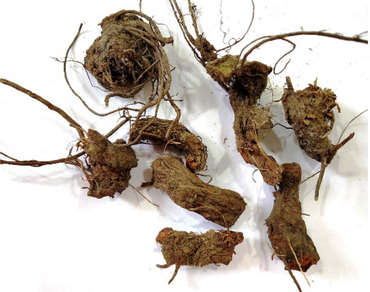Quality control profiling, nutritional analysis and phytochemical standardization of a vegetable root Begonia roxburghii
Prasad Rupali S., Dhaswadikar Suhas R., Laloo Damiki, Dhobi Mahaveer, Itankar Prakash R., Prasad Satyendra K.
Research Articles | Published: 30 August, 2022
First Page: 842
Last Page: 850
Views: 3495
Keywords: Begonia roxburghii , Begoniaceae, Rutin, Heavy metals, Nutritional analysis, Quality control
Abstract
The plant Begonia roxburghii (Miq.) A.DC (Begoniaceae) is a shrub widely distributed in the Himalayan regions of North East India. In Meghalaya and Assam states of India, the plant is regularly used as vegetables and the roots of the plant are traditionally used in the treatment of diarrhoea, bronchitis, dysentery, candidiasis, colds, in digestive disorders and liver problems. The present investigation was undertaken for the first time to report the complete cytomorphological and quality control profile of the roots from the plant. The study included morphological, microscopical, physicochemical and nutritional analysis. Further, the root extract was also subjected to phytochemical screening and quantitative estimation of various identified phytoconstituents and HPTLC standardization. Morphologically, the roots appeared brown, bulb shaped and tapering towards base, while microscopical examination of the root showed the presence of cortical cells with brown content, cork cambium, lignified xylem fibers, simple or compound starch grains and clustered oxalate crystals. All the physicochemical parameters, heavy metals, microbial counts were found to be within the limits of WHO guidelines, while aflatoxins were absent and nutritional analysis showed the presence of essential elements viz. Ca, Cu, Fe, K, Mg and Zn. The phytochemical standardization revealed the roots extract to be highly rich in flavonoids and tannins, while rutin quantified using HPTLC was found to be 6.83% w/w. Thus, the quality control profile developed through this study could be used as referential source for further research and also to minimize adulteration.

References
Amir M, Ahmad N, Sarfaroz M, Ahmad W, Ahmad S, Mujeeb M, Pottoo FH (2019) Tamarindus indica Fruit: Pharmacognostical Standardization, Detection of Contaminant, and In Vitro Antioxidant Activity. J Pharm Bioallied Sci 11:355–363
Anonymous (2002) Quality Control Methods for Medicinal Plant Materials, An Authorized publication of World Health Organization, Geneva. (A.I.T.B.S. Publishers & Distributors (Regd) Delhi, India).
Bolleddu R, Narasimhaji CV, Venkatesh S, Sharma R, Mangal AK, Prasad PVV (2022) Establishment of quality parameters for fruits of Crotalaria pallida Aiton. through microscopy and phytochemical studies. Vegetos. https://doi.org/10.1007/s42535-022-00361-y
Gang C, Faming Z (2016) A conditioning decoction for treating spleen deficiency, Machine Translation (CN 105381372 A 20160309).
Hemalatha S, Sharma P, Prasad SK (2016) Quality Control standardization of Wild Himalayan Pear: Pyrus pashia. Pharmacog J 8:352–360
Hiai S, Oura H, Nakajima T (1976) Color reaction of some sapogenins and saponins with vanillin and sulfuric acid. Planta Med 29:116–122
Hynniewta SR, Kumar Y (2008) Herbal remedies among the Khasi traditional healers and village folks in Meghalaya. Indian J Trad Know 7:581–586
Kapu SD, Nagwai YB, Kayode O, Akan PA, Wambehe C, Gamaniel K (2001) Anti-inflammatory, analgesic and anti-lymphocytic activities of the aqueous extract of Crinum giganteum. J Ethnopharmacol 78:7–13
Kayang H (2007) Tribal knowledge on wild edible plants of Meghalaya, Northeast India. Indian J Trad Know 6:177–181
Khandelwal KR, Sethi V (2018) Practical Pharmacognosy, Techniques and Experiments. (Nirali Prakashan, Pune, India).
Kumar P, Mahato DK, Kamle M, Mohanta TK, Kang SG (2017) Aflatoxins: a global concern for food safety, human health and their management. Front Microbiol 7:2170
Kumari A, Baskaran P, Staden JV (2017) In vitro regeneration of Begonia homonyma—A threatened plant. S Afr J Bot 109:174–177
Laloo D, Hemalatha S (2011) Ethnomedicinal plants used for diarrhea by tribals of Meghalaya, Northeast India. Pharmacog Rev 5:147–154
Madhu C, Krishna KM, Reddy KR, Lakshmi PJ, Kelari EK (2017) Estimation of crude fibre content from natural food stuffs and its laxative activity induced in rats. Int J Pharm Res Health Sci 5:1703–1706
Nagani K, Kaneria M, Chanda S (2012) Pharmacognostic studies on the leaves of Manilkara zapota L. (Sapotaceae). Pharmacog J 4:38–41
Paşayeva L, İnce U, Fatullayev H, Ceylan C, Tugay O (2021) Hypoglycemic, antioxidant, antimicrobial activities and phytochemical analyses of Rhaponticoides iconiensis leafy stem extracts. Vegetos 34:592–599
Patel K, Patel DK (2019) Bioactive Food as Dietary Interventions for Arthritis and Related Inflammatory Diseases. Elsevier Publication, London
Paul BN, Chanda S, Das S, Singha P, Pandeya BK, Giri SS (2014) Mineral assay in atomic absorption spectroscopy. Beats Nat Sci 1:1
Prasad SK, Sahu AN, Hemalatha S (2012) Cytomorphological and physicochemical evaluations of Cryptocoryne spiralis (Retzius) Wydler. J Herbs Spices Med Plants 18:304–307
Prasad SK, Laloo D, Kumar M, Hemalatha S (2013) Quality control standardization and antioxidant activity of roots from Eriosema chinense. Pharmacog J 5:149–155
Rathbone DA, Bruce NC (2002) Microbial transformation of alkaloids. Curr Opin Microbiol 5:274–281
Samant SS, Pant S (2006) Diversity, distribution pattern and conservation status of the plants used in liver diseases/ailments in Indian Himalayan region. J Mount Sci 3:28–47
Sheoran S, Nidhi P, Kumar V, Singh G, Lal UR, Sourirajan A, Dev K (2019) Altitudinal variation in gallic acid content in fruits of Phyllanthus emblica L. and its correlation with antioxidant and antimicrobial activity. Vegetos 32:387–396
Singh S, Verma D (2022) Morphological and anatomical characterization of Fagopyrum esculentum Moench: a highly used medicinal plant in old and new world. Vegetos. https://doi.org/10.1007/s42535-022-00376-5
Urwat U, Zargar SM, Manzoor M, Ahmad SM, Ganai NA, Murtaza I, Khan I, Nehvi FA (2019) Morphological and biochemical responses of Phaseolus vulgaris L. to mineral stress under in vitro conditions. Vegetos 32:431–438
Author Information
Department of Pharmaceutical Sciences, Rashtrasant Tukadoji Maharaj Nagpur University, Nagpur, India